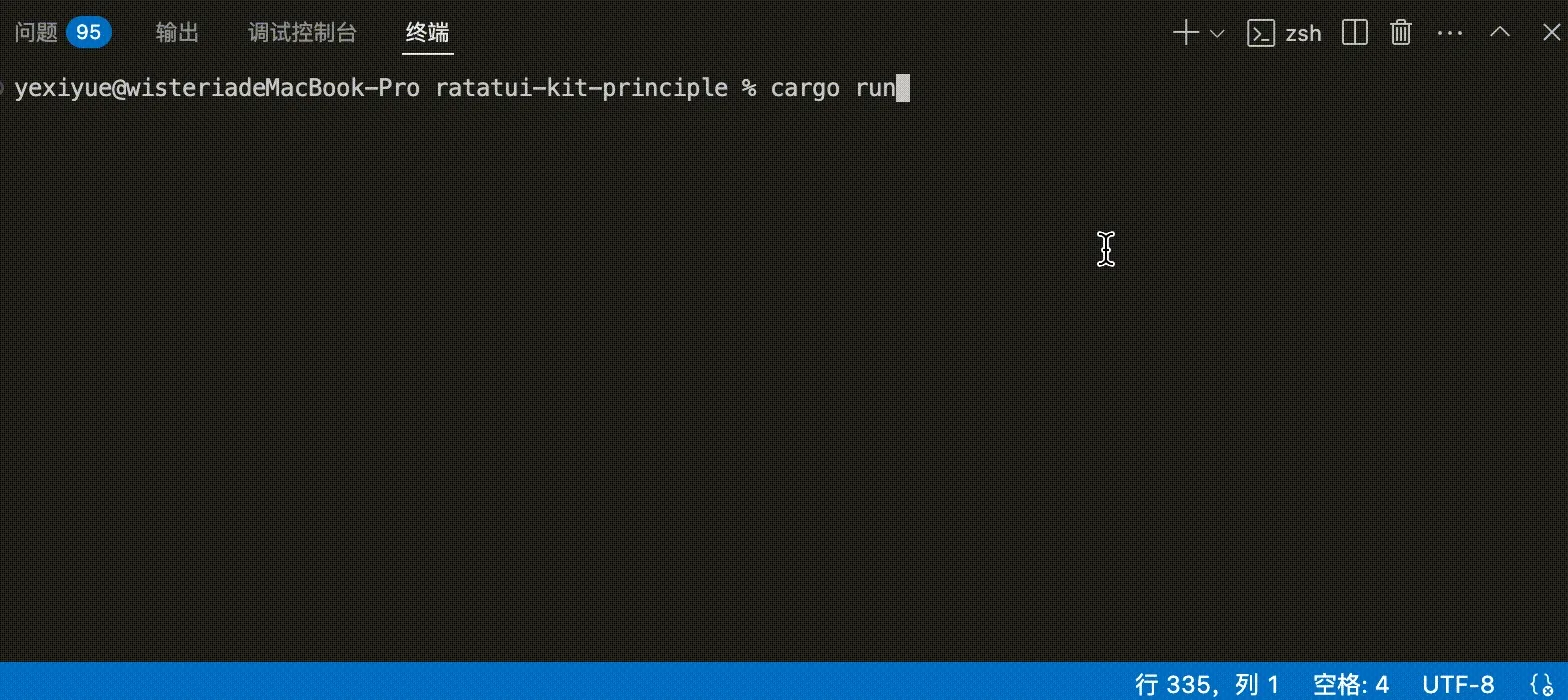状态管理
上一节我们详细介绍了 Hook 系统的工作方式,帮助组件开发者实现了响应式副作用和生命周期扩展点。这一节,我们继续聊聊终端 UI 组件开发中非常重要的能力——状态管理。
1. use_future —— 组件里的异步任务
Section titled “1. use_future —— 组件里的异步任务”use_future 让你可以在组件内部声明一个异步任务(Future),每次渲染时框架会自动帮你轮询它的状态,直到任务完成。这样一来,处理异步请求、定时任务等场景就变得很简单,也不用自己手动管理 Future 的生命周期。
主要特点:
- 只要传入 Future,框架会自动轮询
- Future 完成后会自动清理
- 组件卸载时会自动丢弃 Future,避免资源泄漏
- 如果需要 UI 刷新,建议配合 use_state 一起用
实现思路:
use_future 的核心在于用一个结构体把 Future 包起来,然后让它参与组件的异步轮询流程。大致代码如下:
// 用结构体包裹 Future
pub struct UseFutureImpl {
f: Option<BoxFuture<'static, ()>>, // 存储待轮询的 Future
}
impl UseFutureImpl {
pub fn new<F>(f: F) -> Self
where
F: Future<Output = ()> + Send + 'static,
{
UseFutureImpl {
f: Some(Box::pin(f)),
}
}
}通过实现 Hook trait,这个结构体就能在组件生命周期里自动轮询 Future:
impl Hook for UseFutureImpl {
fn poll_change(
mut self: std::pin::Pin<&mut Self>,
cx: &mut std::task::Context,
) -> std::task::Poll<()> {
// 轮询 Future,完成后清除
if let Some(future) = self.f.as_mut() {
if future.as_mut().poll(cx).is_ready() {
self.f = None; // 清除已完成的 future
}
}
Poll::Pending
}
}这样,异步任务就能和组件的生命周期自然结合,需要时自动触发 UI 更新。
2. use_state —— 组件内部的状态管理
Section titled “2. use_state —— 组件内部的状态管理”use_state 是 Ratatui Kit 里最常用的状态管理 Hook。它让你可以在组件内部声明和管理本地状态,实现响应式 UI。
目标:
- 提供简单易用的 API,像 React 的 useState 一样
- 状态访问是线程安全的
- 状态变更会自动触发 UI 更新
- 状态存储和访问效率高
实现思路:
use_state 的实现其实就是把状态值包裹起来,配合一些辅助结构,帮你自动追踪变更、唤醒 UI 更新。
1. 状态的存储单元
Section titled “1. 状态的存储单元”状态值会被包在一个结构体里,里面除了值本身,还会记录唤醒用的 Waker 和变更标记:
struct StateValue<T> {
value: T,
waker: Option<Waker>,
is_changed: bool,
}2. 状态句柄
Section titled “2. 状态句柄”State 结构体对外暴露了状态的访问接口,开发者可以通过它安全地读写状态值,不用担心并发和生命周期问题:
pub struct State<T: Send + Sync + 'static> {
inner: GenerationalBox<StateValue<T>, SyncStorage>,
}3. 状态引用
Section titled “3. 状态引用”StateRef 和 StateMutRef 分别用来管理只读和可变引用,保证引用安全,并且自动追踪变更:
pub struct StateRef<'a, T: 'static> {
inner: <SyncStorage as AnyStorage>::Ref<'a, StateValue<T>>,
}
impl<T: 'static> Deref for StateRef<'_, T> {
type Target = T;
fn deref(&self) -> &Self::Target {
&self.inner.value
}
}
pub struct StateMutRef<'a, T: 'static> {
inner: <SyncStorage as AnyStorage>::Mut<'a, StateValue<T>>,
is_deref_mut: bool,
}
impl<T: 'static> Deref for StateMutRef<'_, T> {
type Target = T;
fn deref(&self) -> &Self::Target {
&self.inner.value
}
}
impl<T: 'static> DerefMut for StateMutRef<'_, T> {
fn deref_mut(&mut self) -> &mut Self::Target {
self.is_deref_mut = true;
&mut self.inner.value
}
}当你用 StateMutRef 修改状态时,会自动标记变更,释放引用时会唤醒 Waker。
4. Hook 集成
Section titled “4. Hook 集成”UseStateImpl 结构体负责把状态和 Hook 生命周期结合起来,检测变更并驱动 UI 更新:
struct UseStateImpl<T> {
state: State<T>,
_storage: Owner<SyncStorage>,
}
impl<T> Hook for UseStateImpl<T> {
fn poll_change(
mut self: std::pin::Pin<&mut Self>,
cx: &mut std::task::Context,
) -> std::task::Poll<()> {
if let Ok(mut value) = self.state.inner.try_write() {
if value.is_changed {
value.is_changed = false;
Poll::Ready(())
} else {
value.waker = Some(cx.waker().clone());
Poll::Pending
}
} else {
Poll::Pending
}
}
}这样,状态的生命周期就和组件绑定在一起,实现了自动化的状态管理和 UI 响应。
状态流转过程
Section titled “状态流转过程”use_state 的状态流转大致如下:
- 组件里用 use_state 声明一个状态
- 框架帮你把状态值包起来
- 你可以用只读或可写引用来访问和修改状态
- 改了状态会自动打上“已变更”标记
- 框架检测到变更后会唤醒 UI 更新
- UI 重新渲染,显示最新状态
graph TD
A[组件里声明 use_state] --> B[框架包裹状态值]
B --> C{访问状态}
C -- 只读 --> D[获取只读引用]
C -- 可写 --> E[获取可写引用并修改]
E --> F[自动标记已变更]
F --> G[框架唤醒 UI 更新]
D --> H[UI 渲染]
G --> H小结:
use_state 让你可以像写普通变量一样管理组件内部的状态,所有的并发安全、变更追踪和 UI 刷新都由框架自动处理。这样开发者只需要专注于业务逻辑,写起来既简单又高效。
3. 示例代码讲解与优化
Section titled “3. 示例代码讲解与优化”下面通过一个完整的例子,演示如何在组件中结合 use_state 和 use_future 实现一个自增计数器,并优化主循环的事件响应。
首先,我们为之前的 Text 和 Border 组件实现 update 方法,让它们能根据新的 props 更新自身内容:
impl Component for Text {
type Props<'a> = TextProps<'a>;
// ...
fn update(
&mut self,
props: &mut Self::Props<'_>,
_hooks: hooks::Hooks,
_updater: &mut ratatui_kit_principle::render::updater::ComponentUpdater<'_>,
) {
*self = Self {
text: props.text.to_string(),
style: props.style,
alignment: props.alignment,
};
}
}
// ...
impl Component for Border {
type Props<'a> = Style;
// ...
fn update(
&mut self,
props: &mut Self::Props<'_>,
_hooks: hooks::Hooks,
_updater: &mut ratatui_kit_principle::render::updater::ComponentUpdater<'_>,
) {
self.border_style = props.clone();
}
//...
}接下来,新建一个 Counter 组件。它用 use_state 管理计数器的值,并用 use_future 启动一个异步任务,每隔一秒自动加一:
pub struct Counter;
impl Component for Counter {
type Props<'a> = ();
fn new(_props: &Self::Props<'_>) -> Self {
Counter
}
fn update(
&mut self,
_props: &mut Self::Props<'_>,
mut hooks: hooks::Hooks,
updater: &mut ratatui_kit_principle::render::updater::ComponentUpdater<'_>,
) {
let mut state = hooks.use_state(|| 0);
hooks.use_future(async move {
loop {
// 模拟异步操作,比如从服务器获取数据
tokio::time::sleep(std::time::Duration::from_secs(1)).await;
state.set(state.get() + 1); // 更新状态
}
});
let counter_text = format!("Count: {}", state.get());
let element = Element::<View> {
key: ElementKey::new("root"),
props: ViewProps {
children: vec![
Element::<View> {
key: ElementKey::new("header"),
props: ViewProps {
children: vec![
Element::<Text> {
key: ElementKey::new("title"),
props: TextProps {
text: "Welcome to the Counter App",
style: Style::default().bold().light_blue(),
alignment: ratatui::layout::Alignment::Center,
},
}
.into(),
],
height: Constraint::Length(1),
..Default::default()
},
}
.into(),
Element::<View> {
key: ElementKey::new("body"),
props: ViewProps {
children: vec![
Element::<Text> {
key: ElementKey::new("number"),
props: TextProps {
text: counter_text.as_str(),
style: Style::default().light_green(),
alignment: ratatui::layout::Alignment::Center,
},
}
.into(),
],
height: Constraint::Fill(1),
..Default::default()
},
}
.into(),
Element::<View> {
key: ElementKey::new("footer"),
props: ViewProps {
children: vec![
Element::<Text> {
key: ElementKey::new("info"),
props: TextProps {
text: "Press q or Ctrl+C to quit, + to increase, - to decrease",
style: Style::default().yellow(),
alignment: ratatui::layout::Alignment::Center,
},
}
.into(),
],
height: Constraint::Length(1),
..Default::default()
},
}
.into(),
],
flex_direction: Direction::Vertical,
gap: 3,
..Default::default()
},
};
updater.update_children([element]);
}
}在 update 方法里,use_state 用来声明和获取状态,use_future 用来定时更新状态。每次状态变化,UI 会自动刷新。
然后,修改 main 函数,直接渲染 Counter 组件:
// 主程序入口,构建组件树并启动渲染循环
#[tokio::main]
async fn main() -> io::Result<()> {
let mut element = Element::<Counter> {
key: ElementKey::new("counter_app"),
props: (),
};
element.render_loop().await?;
Ok(())
}运行后,你会看到界面上的数字每秒自动加一。

不过你可能会发现,按 Ctrl+C 退出时,程序有时会卡顿。这是因为原来的渲染循环是先等待状态变更,再处理事件,导致响应不够及时:
// 等待组件树有状态变更(如 Hook、子组件等),避免无效刷新,提高性能
self.root_component.wait().await;
// 监听并处理用户输入事件
if let Some(Ok(event)) = event_stream.next().await {
if let Event::Key(key) = event {
match key.code {
KeyCode::Char('q') => break,
KeyCode::Char('c') if key.modifiers.contains(KeyModifiers::CONTROL) => {
break;
}
_ => {}
}
}
}为了解决这个问题,我们可以用 select! 宏同时监听状态变更和用户输入事件。这样无论是状态变化还是用户按键,程序都能第一时间响应:
pub async fn render_loop(&mut self) -> io::Result<()> {
let mut terminal = ratatui::init();
let mut event_stream = EventStream::new();
loop {
// 渲染 UI
self.render(&mut terminal)?;
select! {
_ = self.root_component.wait().fuse()=>{
}
event = event_stream.next().fuse()=>{
match event {
Some(Ok(event)) => {
if let Event::Key(key) = event {
match key.code {
KeyCode::Char('q') => break,
KeyCode::Char('c') if key.modifiers.contains(KeyModifiers::CONTROL) => {
break;
}
_ => {}
}
}
}
_ => break,
}
}
}
}
ratatui::restore();
Ok(())
}这样优化后,按下 Ctrl+C 或 q 时,程序能立刻退出,不会再卡顿。
本节我们系统梳理了 Ratatui Kit 的状态管理原理,了解了 use_state 如何让组件拥有本地响应式状态,use_future 如何优雅地处理异步副作用。通过实际例子,你可以看到这些能力让终端 UI 的开发变得更简单、更高效。
下一节我们将进入终端事件处理的主题,介绍如何用 use_events 让组件优雅地响应键盘、鼠标等各种输入事件,让你的终端应用变得更加灵活和可交互,敬请期待!